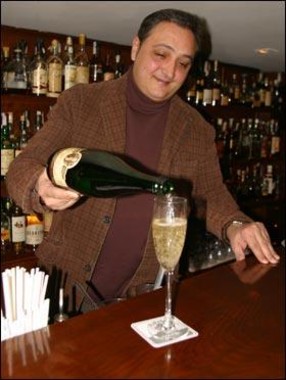Spain’s Sparkling Secret
December 26, 2005 - The Miami Herald

SANT SADURNI D’ANOIA, Spain - BY JOE RAY
It’s peak production time for Cava, Spain’s sparkling wine, and a handful of small producers here are hoping to boost the bubbly’s appeal outside the country.
Though practically unknown in the United States except under the two biggest export brands, Freixenet and CodornÃu, that’s not the case in Spain.
At Ideal Cocktail Bar, one of the classiest places in Barcelona to get a drink since its opening in 1931, they only serve one brand—Mont-Ferrant—but they serve a lot of it. Elegant barmen in white jackets pour about 10 bottles per day to the clients who sit at the wooden bar or sink into the leather banquettes.
Not bad for a place that specializes in whiskey.
‘‘My grandmother started serving Cava by the glass here 40 years ago,’’ says Ideal’s owner, José MarÃa Gotarda. “She was one of the first people in town to do it.’‘
In Spain and particularly in the Catalán region where most Cava is produced and consumed, the beverage rivals beer and wine in popularity. Walk into just about any bar or restaurant in Barcelona and many of the people spilling out the doors have a glass in their hand.
‘In some parts of Spain, people say, ‘I’ll have a beer,’ ‘’ says Gotarda. ‘Here, they say, ‘I’ll have a Cava.’ ‘’
APPEALING PRICE
The major key to Cava’s Catalán ubiquity is price. While a bottle of decent French Champagne will set you back $30 or more, that same $30 will buy some of the best Cava being made, leaving most Spaniards to wonder why anyone bothers with anything else.
Price is the key reason behind the success Cava has both in Spain and exporting around the world. Statistics from the Spanish Institute for Foreign Trade show that Cava accounted for 7.4 percent of all wines exported from Spain in 2004—no small feat from a country that is a world leader in wine production. Three countries buy up most of the Cava exports: Germany, the United Kingdom and the United States, which buy 40.2, 21.5 and 13 percent, respectively.
Many experts both here and around the world say there has been a noticeable hike in quality over the past 10 years, something the small producers are now trying to leverage. ‘‘Cava has grown up quite a bit,’’ says Gotarda.
This shift toward quality has been hard to see in the United States, which tends to import the stuff that’s lower in quality and price.
‘‘I think there’s no perception of what Cava is,’’ says Josep Jové, export manager at Albet i Noya. ‘Most people think of it as ‘the cheap champagne that comes from Spain.’ ‘’
What small vineyards like Albet i Noya in the village of Sant Pau d’Ordal are learning to leverage in the United States is selling on bang for the buck.
ORGANIC PRODUCTION
Though the vineyard has been producing organic wines and Cavas for 27 years, that’s not the prime selling point used by Albet i Noya. Not only does it not make a big show out of being organic, it keeps its prices in line with competitors’ offerings.
‘‘The consumer gets enough confusing information. Most people who are coming home from work are buying on price,’’ Jové explains.
Down at Cava producer Gramona in Sant Sadurnà d’Anoia, Cava makers agree that quality is the key to cracking the U.S. market. Before selling the first bottle stateside, marketing director Montserrat Alonso spent time there learning the terrain.
She returned to Spain with an observation and an idea she feared might make the management balk: Avoid what one well-known sommelier refers to as the ‘‘Coca-Cola approach’’ and instead offer only the best bubbly in the United States, even though the vineyard could easily sell it—and make more money doing so—in Spain.
QUALITY COUNTS
‘‘The population was waiting for something good,’’ she says, “not something cheap.’‘
Her bet paid off. Gramona is now available in 25 states, and the United States already makes up half of Gramona’s export sales.
‘‘When people know about wine, they spend a lot of money on it,’’ Alonso says with a grin.
Gramona director Jaume Gramona agrees that selling on value, not volume, is his company’s best bet.
‘‘The day Cava starts costing more, we’re in deep trouble,’’ he says, speaking about the market in Germany, but it’s clear that he could be speaking about anywhere else in the world, including Spain.
Gramona—who begins most of his days with a workout between six and seven in the morning, followed by a breakfast of tomato bread and a glass of Cava (’‘But only when I work out!’’ he promises)—is ready to see the bubbly be known for what it is, not as a Champagne substitute.
‘‘It used to be that everything that was good here was imported. It was cooler to get Champagne when you brought a girl out,’’ says Gramona, “That’s not the case anymore.’‘
Joe Ray is a freelance food writer based in Paris.